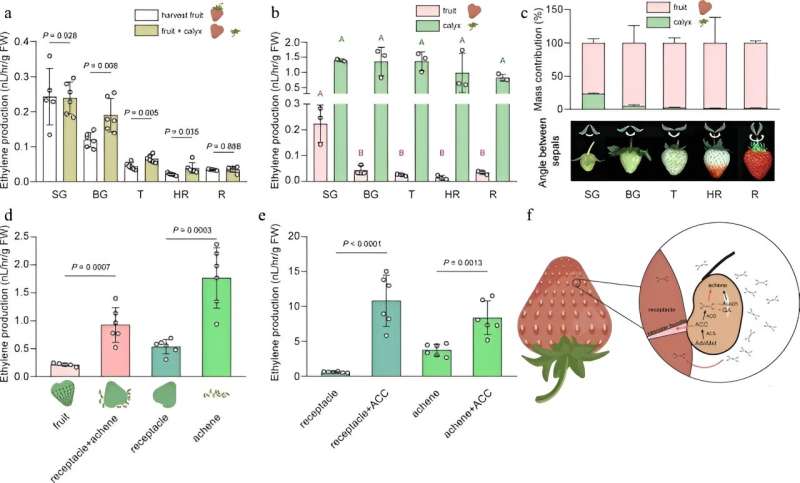This article has been reviewed according to Science X's editorial process and policies. Editors have highlighted the following attributes while ensuring the content's credibility:
fact-checked
trusted source
proofread
Rethinking ripening: Ethylene's expanded role in strawberry fruit development and maturation

A research team has discovered a potential role for ethylene in the maturation of strawberry fruits, specifically the true fruit—achenes—embedded in the fleshy receptacle. This finding challenges the traditional view that strawberries have a minimal dependence on ethylene for fruit development.
The study highlights the necessity for advanced tools such as ethylene detection sensors and genetically engineered mutants to further investigate ethylene's roles. These insights could lead to enhanced fruit quality and ripening techniques, presenting significant implications for agricultural practices and food production.
Strawberries are cherished for their delightful appearance, flavor, and nutritional content, making them an ideal model for studying fruit development and ripening. Current research has extensively examined the role of plant hormones like auxin and gibberellic acid in early development, while abscisic acid plays a critical role during ripening stages. However, the role of ethylene, a key hormone in ripening, remains ambiguous in strawberries.
Traditionally, strawberry is considered to be a non-climacteric fruit and is less dependent on ethylene during fruit development. This classification overlooks the varied ethylene production across the tissue heterogeneity of a harvest fruit. Given the complex structure of harvested strawberries, which includes the calyx, receptacle, and achenes, further research is necessary to elucidate the specific function of ethylene in the ripening process of these heterogeneous tissues.
The study published in Fruit Research on 2 April 2024, determines ethylene production at different stages and heterogeneous tissues, in order to explore the effect of ethylene on strawberry fruit development.
Researchers discovered that ethylene production increased during the big green (BG), turning (T), and half red (HR) stages when the calyx was removed, indicating a possible wound-induced production of ethylene. This production is linked to the upregulation of ACC synthase genes (ACS) in the receptacle, highlighting how physical damage might enhance ethylene output.
In addition, in five stages where the calyx was intact, the calyx itself produced significantly more ethylene than the fruit, especially at the small green (SG) stage, suggesting that the calyx contributes a substantial amount of ethylene during fruit growth and ripening.
To investigate the levels of ethylene production in the receptacle and achenes, the researchers conducted an experiment wherein the removal of achenes led to a significant increase in ethylene production, nearly four times as much as the receptacle alone. Moreover, feeding the ethylene biosynthetic precursor ACC to the achenes and receptacles significantly enhanced ethylene levels, especially in the receptacles, suggesting that these tissues might have a high baseline ACO activity.
This unexpected result indicates a complex interplay between ACC transport and ethylene production within the fruit, pointing to the possibility of localized ACO activity at the achene-receptacle junction, potentially facilitated by vascular transport.
The study's senior researcher, Dongdong Li, says, "This intricate process is likely to exert ripple effects on the subsequent growth and ripening of the receptacle."
Overall, this perspective article points out that the intricate mechanism underscores the nuanced role of ethylene in strawberry fruit development, necessitating further investigation to elucidate its full impact, particularly how ethylene and other hormonal signals interact within the heterogeneous tissues of the strawberry.
More information: Huixin Chen et al, Spark to blaze: the role of ethylene in achenes and the ripple influences on strawberry fruit growth and ripening, Fruit Research (2024). DOI: 10.48130/frures-0024-0008
Provided by Chinese Academy of Sciences





















